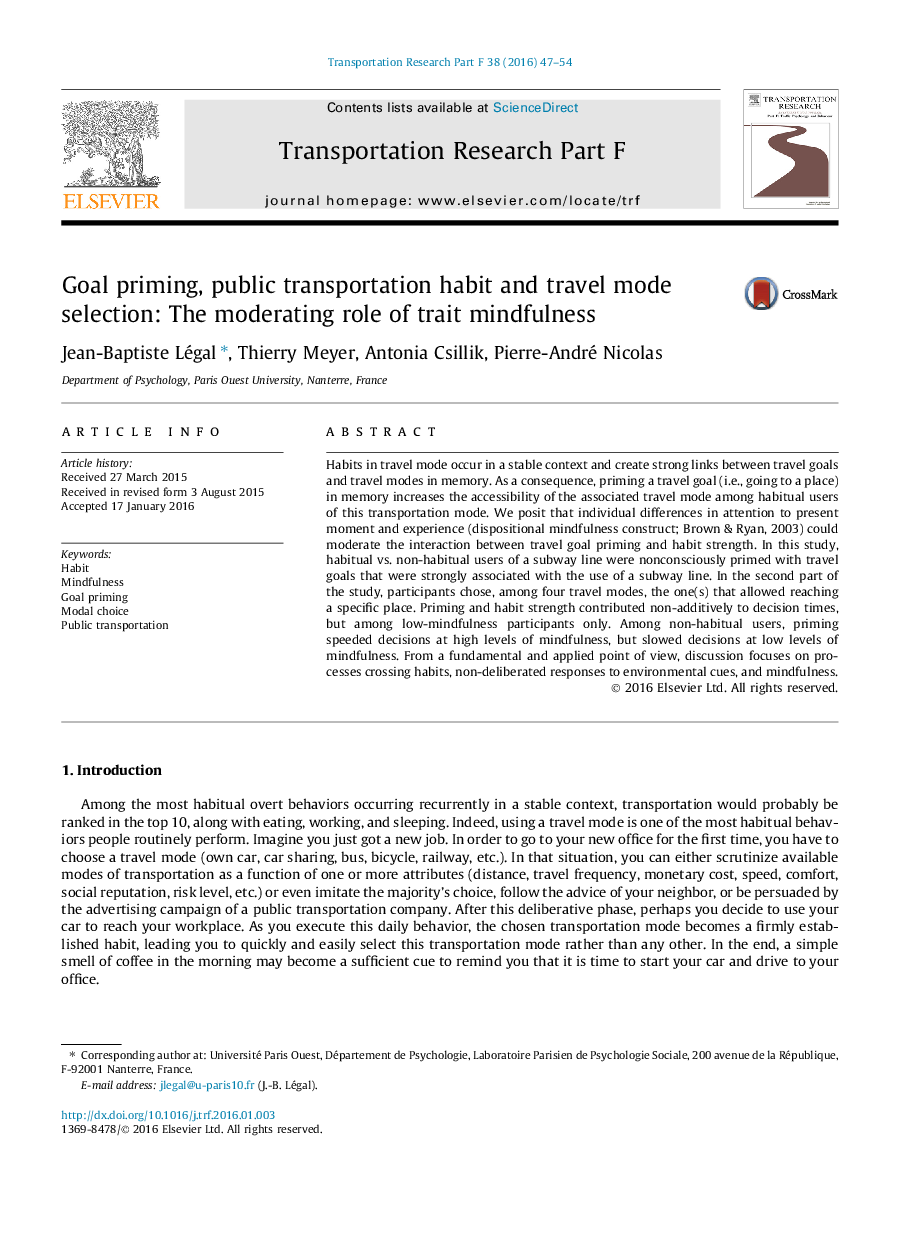| کد مقاله | کد نشریه | سال انتشار | مقاله انگلیسی | نسخه تمام متن |
|---|---|---|---|---|
| 7258133 | 1472445 | 2016 | 8 صفحه PDF | دانلود رایگان |
عنوان انگلیسی مقاله ISI
Goal priming, public transportation habit and travel mode selection: The moderating role of trait mindfulness
ترجمه فارسی عنوان
پر کردن اهداف، عادت حمل و نقل عمومی و انتخاب حالت سفر: نقش تعدیل کننده توجه ذهنی
دانلود مقاله + سفارش ترجمه
دانلود مقاله ISI انگلیسی
رایگان برای ایرانیان
کلمات کلیدی
عادت، ذهن آگاهی، هدف اولیه انتخاب مودال، حمل و نقل عمومی،
ترجمه چکیده
عادت ها در حالت سفر در یک زمینه پایدار رخ می دهد و ارتباطات قوی بین اهداف سفر و حالت های سفر در حافظه ایجاد می کند. در نتیجه، پر کردن یک مقصد سفر (به عنوان مثال، رفتن به مکان) در حافظه، دسترسی به حالت سفر مرتبط را در میان کاربران معمولی این حالت حمل و نقل افزایش می دهد. ما بر این باوریم که تفاوتهای فردی در توجه به لحظه و تجربه فعلی (ساختار تمرکز حواس پرتی، براون و رایان، 2003) می تواند تعامل بین هدف پرورش هدف و قدرت عادت را تعدیل کند. در این مطالعه، کاربران معمولی و غیر معمول در یک خط مترو به طور ناخودآگاه با اهداف مسافرتی که با استفاده از خط مترو مرتبط بودند، ناخواسته پر شده بودند. در بخش دوم مطالعه، شرکت کنندگان در میان چهار حالت سفر، یکی را انتخاب کردند که امکان دستیابی به یک مکان خاص را فراهم کرد. استحکام بذر و عادت به زمان های تصمیم گیری افزوده نمی شد، بلکه تنها در میان شرکت کنندگان در کم توجهی قرار داشت. در میان کاربران غیر معمول، تصمیم گیری های سریع را در سطح بالاتری از ذهنیت انجام می دهد، اما تصمیمات را در سطوح پایین ذهنیت کاهش می دهد. از دیدگاه بنیادی و کاربردی، بحث بر روی عادات فرار از فرایندها، پاسخ های غیرواقعی به نشانه های محیط زیست و ذهنیت تمرکز می کند.
موضوعات مرتبط
علوم انسانی و اجتماعی
روانشناسی
روان شناسی کاربردی
چکیده انگلیسی
Habits in travel mode occur in a stable context and create strong links between travel goals and travel modes in memory. As a consequence, priming a travel goal (i.e., going to a place) in memory increases the accessibility of the associated travel mode among habitual users of this transportation mode. We posit that individual differences in attention to present moment and experience (dispositional mindfulness construct; Brown & Ryan, 2003) could moderate the interaction between travel goal priming and habit strength. In this study, habitual vs. non-habitual users of a subway line were nonconsciously primed with travel goals that were strongly associated with the use of a subway line. In the second part of the study, participants chose, among four travel modes, the one(s) that allowed reaching a specific place. Priming and habit strength contributed non-additively to decision times, but among low-mindfulness participants only. Among non-habitual users, priming speeded decisions at high levels of mindfulness, but slowed decisions at low levels of mindfulness. From a fundamental and applied point of view, discussion focuses on processes crossing habits, non-deliberated responses to environmental cues, and mindfulness.
ناشر
Database: Elsevier - ScienceDirect (ساینس دایرکت)
Journal: Transportation Research Part F: Traffic Psychology and Behaviour - Volume 38, April 2016, Pages 47-54
Journal: Transportation Research Part F: Traffic Psychology and Behaviour - Volume 38, April 2016, Pages 47-54
نویسندگان
Jean-Baptiste Légal, Thierry Meyer, Antonia Csillik, Pierre-André Nicolas,
